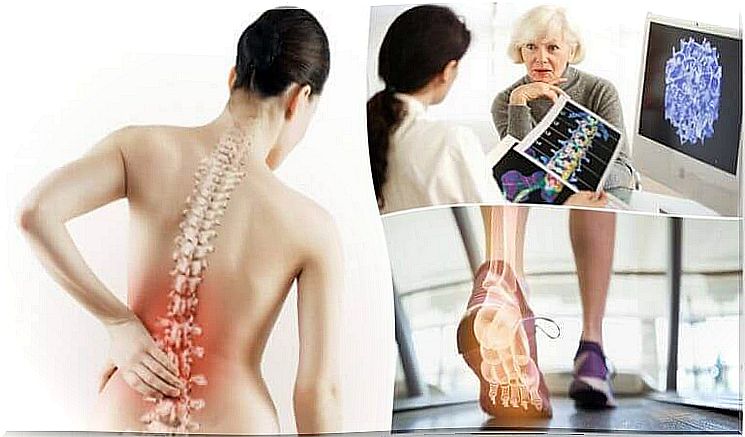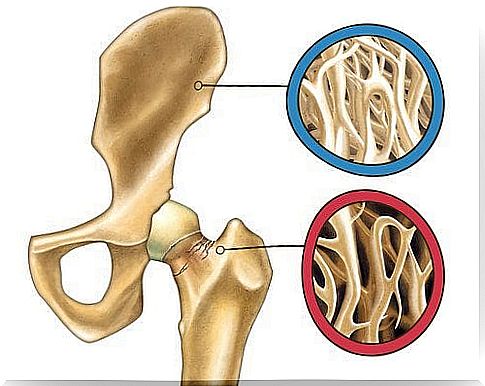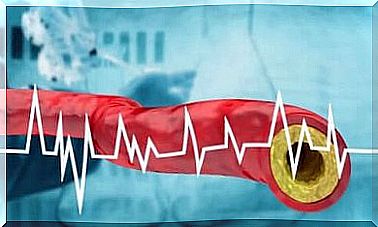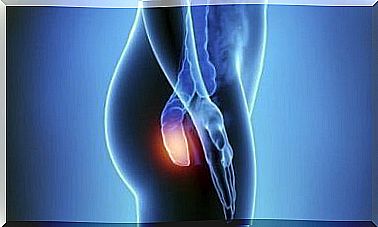6 Things You Should Know About Osteoporosis

Osteoporosis is a bone disease that can be caused by osteoporosis, a vitamin D deficiency or genetic factors. It occurs when internal microstructures of bony parts wear out. This ensures that its density and support capacity decreases. Read this article to learn more about osteoporosis.
When osteoporosis occurs, the risk of fractures increases and inflammatory reactions and severe pain occur.
Although osteoporosis is a common condition in the elderly, it can also affect some people early on. In most cases, this is the result of injuries or habits that affect the bones.

The most disturbing fact is that many still don’t know how serious it can be. In addition, due to the absence of symptoms, some are not even aware that they are suffering from it.
For this reason, it is essential to know more about osteoporosis and how it develops. If any of the risk factors apply to you, see your doctor.
Things you should know about osteoporosis
1. Risk Factors

Weakening of the bones usually occurs due to low calcium and vitamin D absorption. This is especially true as we get older.
- Deficiency of these nutrients reduces bone density and can cause fractures and irreversible damage in the event of injury or illness.
- This situation can occur due to genetic factors, although it is also associated with the hormonal changes that occur in adulthood.
- Excessive consumption of tobacco and alcohol also influences the development of osteoporosis.
- The drop in estrogen levels that occurs during and after menopause is another related cause.
- The risk of osteoporosis also increases if you suffer from anorexia or bulimia.
2. Symptoms
Unfortunately, this disease is a so-called ‘silent enemy’. This means that this disease has no obvious symptoms until it becomes a more serious problem. That’s why it’s so important to know as much as you can about osteoporosis.
- Often, detection only occurs when a person suffers a fracture, before they even know they are suffering from the disease.
- This fracture can be sustained without significant trauma or injury.
- It is possible to suspect the presence of osteoporosis when a person has become between five and eight centimeters shorter.
- Some people develop something known as “kyphosis.” A condition characterized by an aggravation of the natural curvature of the spine.
3. Detection

To detect the disease, a medical examination called BMD must be performed. This examination consists of measuring bone mineral density.
- This means that an X-ray is made with little radiation. Making the X-ray does not take much time at all and does not cause any pain.
- Studying the spine and hip may indicate a fracture.
- Normal X-rays of other bones are usually not accurate enough to really show osteoporosis.
4. Prevention
While there are many factors that can lead to the development of this condition, the continual adoption of healthy habits is key to minimizing the risks.
- It is therefore essential to a promote optimal absorption of calcium and vitamin D through foods that contain these vitamins in your diet to include.
- The National Osteoporosis Foundation (NOF) recommends intakes of 1,000 mg of calcium per day for adults and 1,200 mg per day for women over 50 years of age and men over 70 years of age.
- In addition, it is important to limit your consumption of sodium and saturated fats. These substances hinder calcium absorption.
- It is important to increase the absorption of magnesium, because magnesium also helps to maintain bone density.
- Daily exercise is very sensible as it helps to strengthen bones and improve your coordination and balance.
5. Medication to counteract the problem

Currently, several drugs exist to combat loss of bone density. These drugs can therefore also help prevent serious problems, such as fractures.
- For example, bisphosphonates exist , which prevent bone loss by inactivating cells known as osteoclasts. These are cells that absorb bone tissue.
- Calcium and vitamin D supplements are also recommended, especially if their absorption through food is difficult.
- Estrogen treatments often help prevent and fight the disease in menopausal women.
6. Side Effects of the Treatments
Although drugs for the treatment of this disease are effective in many cases, it is important to know that long-term use can cause side effects in most cases.
Possible side effects include:
- Joint and muscle pain
- esophagus damage
- Heartburn
- Cardiac arrhythmias and palpitations
In addition, we should also mention that while they can effectively treat osteoporosis, the aforementioned drugs also have a “deadline” to take effect. This means that after about three years it is necessary to analyze how much these drugs have helped and what negative effects they have had.
In certain cases, it is necessary to stop the medication for some time, as long-term use is dangerous.
The best way to deal with osteoporosis is to do what you can to prevent it and learn as much as you can about osteoporosis. If you belong to the risk group, it is also important to have your bone density measured regularly.









